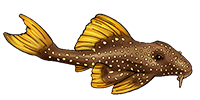| Scientific Name | Corydoras fulleri Tencatt, Santos, Evers & Britto, 2021 |
| Common Names | C115, Fuller's Cory C116, Fullers Pansermalle (Denmark) |
| Type Locality | Stream tributary of the upper río Manuripe (or Manuripi), locally known as Alegría, a tributary of the río Orthon, rio Madeira basin, Las Piedras, Tambopata, Madre de Dios, Peru, 12°06'02"S, 69°03'28"W. |
| Pronunciation | kor ee doh rass. |
| Etymology | Cory = helmet, doras = skin. In this case it was incorrectly used to mean armour (cuirasse) instead of skin in allusion to the dual rows of plates that run along the flanks of this genus. This species is named in honour of Ian A. M. Fuller, an aquarist who devoted most of his life keeping and breeding Corydoradinae species. |
| Size | 65mm or 2.6" SL. Find near, nearer or same sized spp. |
| Identification | Corydoras are identified by their twin rows of armour plates along the flanks and by having fewer than 10 dorsal fin rays. They are most commonly confused with the other genera in the sub-family, namely Brochis, Scleromystax and Aspidoras. C115 = C116. Captive breeding has shown these two c-numbers to be the same, highly variable species. C115 without the mid body blotch, C116 with. |
| Sexing | Females grow larger and are more full-bodied, this is best observed from above the fish. Males will typically have more pointed as opposed to more rounded fin tips as they mature. |
| Distribution | Rio Madre de Dios, Peru. Amazon, Middle Amazon (Solimoes), Madeira, Madre de Dios (click on these areas to find other species found there) Login to view the map. |
| IUCN Red List Category | Not Evaluated |
| Feeding | Will readily accepted all prepared foods that reach the bottom of the aquarium such as tablets, granules and larger flakes. Live (or frozen) foods such as bloodworm, white worm, grindal worm (Enchytraeus), Daphnia and Tubifex are readily accepted and good for conditioning groups of fishes for spawning. User data. |
| Furniture | Ideally substrate should be sand, but rounded gravel is an imperfect alternative. Avoid keeping over rough edged (chipped) gravel, this will increase this risk of damage the fishes barbels when it tries to dig. Substrate should be bordered with driftwood and aquatic plants leaving an open area for them to search for food and swim. The shade provided by overhanging rock work, arching bogwood, tall or floating plants are all that is required to settle these fishes. |
| Compatibility | A peaceful, shoaling, community fish. |
| Breeding | Unreported. |
| Breeding Reports | There is no breeding report. |
| Reference | Journal of Fish Biology v. 99 (no. 2), pp 2 [615], Figs. 1-4. |
| Registered Keepers | There are 9 registered keepers, view all "my cats" data. |
| Wishlists | Love this species? Click the heart to add it to your wish list. There is no wish to keep this species. |
| Spotters | Spotted this species somewhere? Click the binoculars! There are 9 records of this fish being seen, view them all. |
| Forum BBCode | |
| Search for C. fulleri | |
| Look up C. fulleri on AquaticRepublic.com | |
 | Look up C. fulleri on Fishbase |
 | Look up C. fulleri on Encyclopedia of Life |
 | Look up C. fulleri on Global Biodiversity Information Facility |
| LFS label creator ARN ref:1.1.686.1195 | |
| Last Update | 2025 Jan 02 01:36 (species record created: 2004 Feb 01 00:00) |





/siluriformes/callichthyidae/corydoras/fulleri/1.jpg)
/siluriformes/callichthyidae/corydoras/fulleri/2.jpg)
/siluriformes/callichthyidae/corydoras/fulleri/3.jpg)
/siluriformes/callichthyidae/corydoras/fulleri/4.jpg)
/siluriformes/callichthyidae/corydoras/fulleri/5.jpg)
/siluriformes/callichthyidae/corydoras/fulleri/6.jpg)
/siluriformes/callichthyidae/corydoras/fulleri/7.jpg)
/siluriformes/callichthyidae/corydoras/fulleri/8.jpg)
/siluriformes/callichthyidae/corydoras/fulleri/9.jpg)
/siluriformes/callichthyidae/corydoras/fulleri/10.jpg)
/siluriformes/callichthyidae/corydoras/fulleri/11.jpg)
/siluriformes/callichthyidae/corydoras/fulleri/12.jpg)
/siluriformes/callichthyidae/corydoras/fulleri/13.jpg)